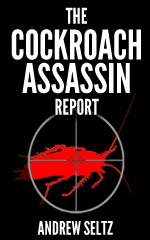Reference
Diatomaceous Earth – A natural powder derived from the fossilized remains of tiny phytoplankton called diatoms. The surface of this powder is microscopically jagged and sharp. It kills cockroaches mechanically by abrading their exoskeleton causing dehydration and death. It does not lose potency over time.
Dinotefuran – A neunicotinoid substance that atcs as a nervous system disruptor. Studies done on rats indicate that this substance may have a negative effect on developing brains in humans, so caution should be used when treating areas where small children are present. It is also suspected as a potential contributor to colony collapse disorder in bees.
ETOC (Prallethrin) – This pyrethroid insecticide is the primary ingredient in Hot Shot Ant & Roach Plus Germ Killer spray. According to the World Health Organization it has low toxicity for mammals and no evidence of being carcinogenic, but it is VERY toxic to bees and fish.
Fenvalerate – This insecticide has moderate toxicity in mammals and affects the central nervous system. It is toxic to bees and fish and is a long lasting poison. Fenvalerate can also irritate the skin and eyes. This is not a good pesticide option.
Fipronil – This insecticie option disrupts the insect central nervous system and causes hyperexcitation of contaminated insects' nerves and muscles. It is used in products like Combat Max Roach Baits and Gels. It is not absorbed substantially through the skin and the likelihood of humans being exposed to this compound in the air is also very low. Fipronil is classified by the EPA as a possible human carcinogen, but it is usually packaged in solid form and covered when used as a roach control product so the changes of exposure are minimal. Fipronil is highly toxic for crustaceans, insects, bees, termites, rabbits, fish, and some birds. Used according to directions in covered bait stations, the chances of negative impact is minimal.
Hydramethylnon – This organic compound is a metabolic inhibitor that has a relatively low persistence in soil and breaks down in water in as little 11 days. It is toxic to fish, but not bees. Overall, it is a good pesticide option.
Hydroprene – for a full description of this substance, see Chapter 5: A Little Cockroach Birth Control.
Pyrethroids – Pyrethroids are a group of potent synthetic insecticides derived from the organic neurotoxin pyrethrin. They attack the nervous systems of all insects.
All pyrethrin derived compounds are highly toxic to fish and other aquatic life. Some studies suggest they may also be a contributing factor to colony collapse disorder in bees causing a disruption in the ability of workers to navigate back to the hive.
In humans, symptoms of toxicity include asthmatic breathing, sneezing, nasal stuffiness, headache, nausea, incoordination, tremors, convulsions, facial flushing and swelling, and burning and itching sensations. These symptoms are more likely with exposure to the synthetic compounds than with organic pyrethrins. A 2011 study found a link between exposure to piperonyl butoxide (a common additive in pyrethroid formulations) in pregnant women in their third trimester and delayed mental development in the unborn child.
Pyrethrins breakdown quickly into organic compounds in the environment with synthetic versions persisting longer than those derived from natural sources. They are generally considered safe to use around food by the United States Department of Agriculture.
Common Pyrethroids include:
- Bifenthrin
- Cypermethrin
- Imiprothrin
- Permethrin
National Pesticide Information Center (NPIC) - NPIC is a cooperative agreement between Oregon State University and the U.S. Environmental Protection Agency providing scientifically-grounded information about pesticides and pesticide-related topics.
U.S Environmental Protection Agency (EPA) - The EPA maintains a section on their website dedicated to pesticides and safe pesticide use. They have a page listing Minimum Risk Pesticides which includes many natural pest control options.
 The Cockroach Assassin Report
The Cockroach Assassin Report
